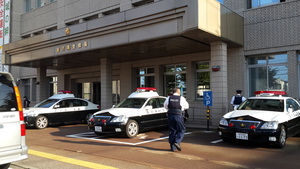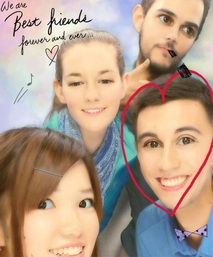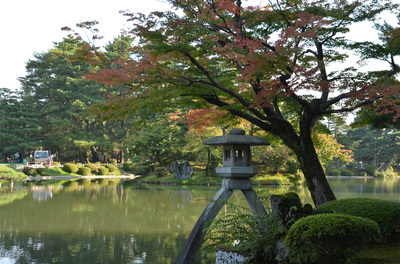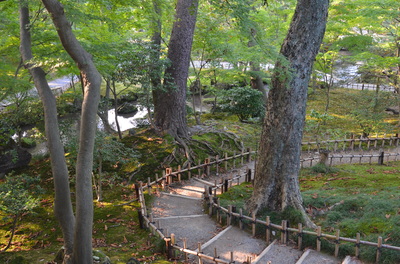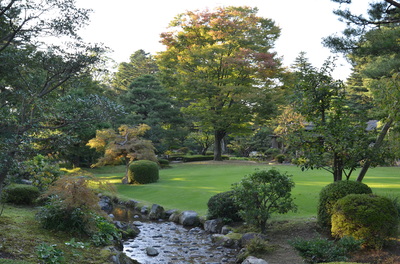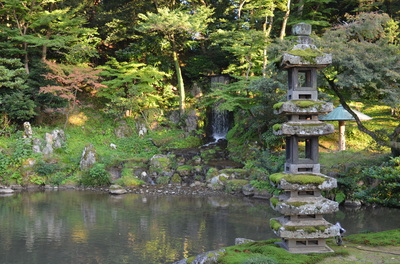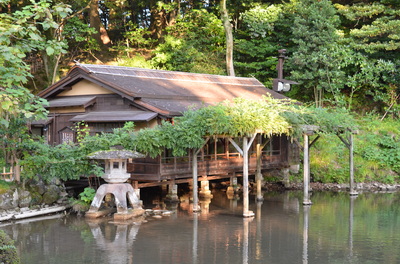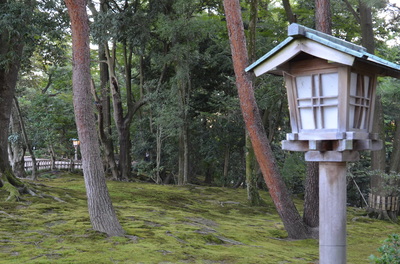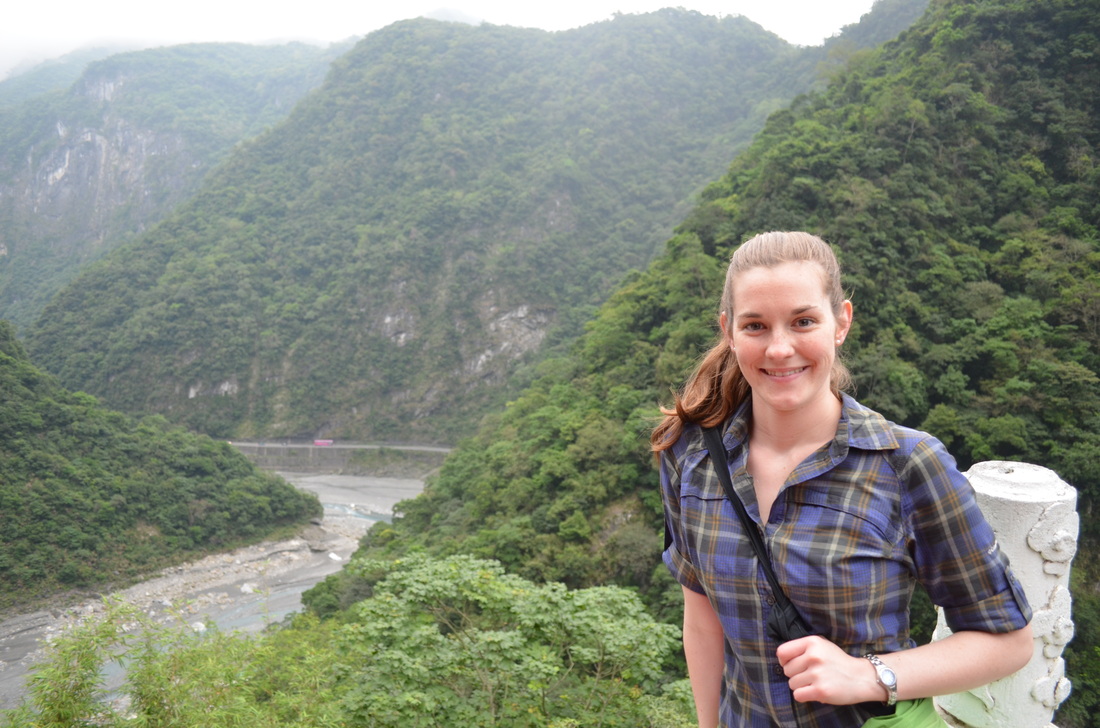Unfortunately, I couldn't take any pictures during the retreat. The temple just posted these photos. Thank you FGS for sharing!
|
What can I advise other travelers to do in the Yamanashi prefecture? Well, I know what to advise them not to do. Shosenkyo Gorge was a very large disappointment. Before arriving, I had read that it is considered Japan’s greatest gorge. Perhaps with the autumn leaves in full swing the gorge could provide some nice views. Regardless, the gorge is not worth going out of your way for. It is only about 4 km long. It has two nice waterfalls and a path you can walk along. If you have been to Taroko Gorge in Taiwan or really any other gorge for that matter, don’t make this trip!
Don’t get me wrong, it is a very nice area. Yamanashi is famous for its mountains and fruit. We have had a wonderful time with our hosts and can’t say enough wonderful things about them! I just strongly suggest spending extra time around Mt. Fuji opposed to Shosenkyo Gorge. The next day was much better. The rain cleared up and we had crystal clear views of Mt. Fuji. It is one of those mountains that you hear so much about and see depicted in ancient artwork that seeing it with your own eyes feels surreal. There were some clouds in the sky and we were feeling a bit worried that we weren’t going to be able to see it. Suddenly, my Dutch friend Tim called out, “LEFT!” Sure enough, behind the car to the left were the gradually inclining slopes of Mt. Fuji. It is so prominent with nothing but green trees leading up to it. This solidarity gives it the feeling of being a strong and wise old man. It is in places like this that I wish the mountain itself could speak to tell us all that it has seen. We happened to be in good fortune, because only a few hours previously had been the first snow fall of the season. The cone of the mountain was lightly dusted, while the slopes retained their dark gray ash color. Fuji surpassed my expectations and made for a very special experience. We spent several hours driving around the five lakes (Lake Motosu, Lake Shojin, Lake Sai, Lake Kawaguchi and Lake Yamanaka) at the mountain’s base. In Fuji-Yoshida's tourist center, we were able to get a map of the region with the 36 famous viewpoints highlighted. The most pristine lake is Lake Sai or Saiko. There were many fishermen enjoying the clear day out in the lake. I put my hand in the clear water and was shocked by how warm and clean it was. I understand why this is such a popular weekend getaway for Tokyo-ites. We stopped at a little café on Saiko and slurped the area’s famous Udon noodles. In addition to taking in the stunning nature around the mountain, we also stopped at the Ice Cave and the Lava Cave. It took longer to put on the boots and helmets than to walk through the caves. I would add these to the category of Shosenkyo Gorge- Skip them! I personally found the Ice Cave humorous because it didn’t have any ice. I guess the only time of year where it really is anything worth seeing is in the spring. The other stop we made was the Aokigahara Jukai or the Sea of Trees (Hanging Forest or Suicide Forest). It is famous for its lack of animal life and for being eerily quiet. Its more depressing claim to fame is that it is the site for hundreds of suicides over the last few decades. Every year since 1970 the government sends in body searches. In 2004 alone, 108 people were found in the forest. There are even signs offering people emotional help if they call the number provided. We did not go in the forest for this reason obviously, but went in search of a nice hiking trail another traveler told us about. We were fortunate to spend yet another night with Mizuki and her family. Her brother is currently in training to be a firefighter and arrived home with his new gear. He was very excited and it was nice to see him so happy. Her father told us about his childhood friend and how his friend has a prominent role in the “family” business. I really like Mizuki’s father and think he is so funny. She told us her friends think he looks like Tupac. He totally does! Thus, we have solved the mystery of Tupac’s death/disappearance. He just came to Japan and pretended to be a Japanese family man. Another great day of great views and great people. Today involved a 5.5 hour drive with a stop in Matsumoto to explore the castle. We started out by saying goodbye to the owner of our local 7 Eleven. She was very cute and gave us chocolate. Due to limited time, we did a quick run through of the old Edo period streets of Takayama. We could have spent more time taking in the area, but the city does not require all that long of a visit. Takayama, along with Kanazawa, has some of the best preserved old streets in the country. Shimo Ninomachi, Shimo Sannomachi, Kami Ninomachi, and Kami Sannomachi all make up the old quarter. The buildings are all made of a dark brown wood and give visitors a chance to feel what a city would have been like long ago.
In the past, Takayama had ample timber and not enough agricultural production. Thus, instead of paying taxes through rice like other regions, the city paid by sending their well-trained carpenters. Its location in the mountains makes it not the easiest city to visit. If you do come this way, make a point of eating its renown ramen and try to time your visit during one of the city's famous festivals. Keep in mind if you are coming by car, parking is hard to find and is usually costs. The drive took us through the mountains and provided some stunning scenery. Once in Matsumoto, we headed straight for the castle. It is one of Japan's best preserved castles. Construction was completed between 1593 and 1594. The entire area covered 39 hectares. The original was much more impressive due to the extensive moat and wall defense system. There were three moats! The samurai and commoners lived separately within the walls with the families of higher status living much closer to the keep itself. Over the centuries, the castle has changed hands between many clans. Inside the castle, there are paintings that depict the many battles it has witnessed. The castle felt smaller than I expected, but I am really glad we were able to make the pit stop! We made it to our lovely host around 9:00 and spent the evening chatting with her family. The typhoon has already sent us an abundance of rain. So we suited up and drove an hour and a half to the secluded mountainous region that is home to Shirakawa-go. It is a village of thatched roof houses (gassho-zukuri) which span from 200 to 400 years old! In 1995 it was registered as a World Heritage site by UNESCO. This traditional architecture is designed to withstand heavy snowfall and yet provide enough space for both living and working. Most of the villagers in the region made/make their living by growing silk worms in the upper levels of their homes. The gassho houses are named for their steep roofs (60 degrees) which look like praying hands. The roof’s angle makes it so that snow and rain fall off quickly. This is important not just for the structure of the building, but also so the straw does not mold and rot. The entire house is built without nails and is incredibly strong. I was really interested by the slates in the floor that allow the smoke and heat from the downstairs fire to rise and help dry the thatch. All the houses are built on the North-South axis to allow the wind of the valley floor to blow through them which increases ventilation. The whole design is ingenious. The roofs are redone every 20 years, but historically if constructed properly could last for 50.
In the past most of these homes housed up to 30 people! I couldn’t believe how spacious the Wada House was when we went inside. Its four floors provided ample living space and an entire two floors dedicated to the silk worms. Come yourself and check out the largest and oldest gassho house. Stroll through the streets, go to the Wada house, and climb the hill to get aerial views of the village! We have met several great people at convenient stores this week. Since we can’t afford the high food prices here, we are getting most of our meals from 7 eleven. The 7 eleven closest to where we are staying is owned by a very cute woman. Her 17 year old daughter also works there and spent a while chatting with us. They are both very enthusiastic each time we come in and ask us many questions. We also stopped at a Family Mart and randomly met a very kind Australian couple. We spent 30 minutes discussing our upcoming trip to Australia. The woman was hilarious and told us about the “scum of the earth” foot ballers, the bad drivers, the tattooing craze, inequality aboriginals face, and finally the natural beauty of Australia. I hope to meet them once I am near Melbourne! Sometimes talking to strangers can open doors! Typhoon number three is headed straight for us. So today we decided to rearrange our schedule and to hike. We drove an hour and a half from Takayama to Shinhotaka. It is an onsen village (one of the five Okuhida onsen villages) located in the Northern Japanese Alps. The area is famous for its natural hot springs and excellent hiking. We paid 2,900 Yen to take the Shinhotaka Ropeway (cable car) up 2,156 m to the Nishihotakaguchi Station. The station has a large viewing platform with expansive views of the surrounding mountains. The area is situated inside a caldera of a volcano that erupted 65 million years ago. It is one of the few places on earth where you can clearly see millions of years’ worth of strata on the rock face of the mountains themselves.
I actually ran into an older Australian woman, whom I met on a train a week ago. I told her we were going to hike up the rest of the mountain and she said to tell the old Australian man hiking to hurry up. Perhaps we will be seeing them again in Tokyo. The hike from the station to Nishiho Lodge takes an hour and half officially. We got there in 45 minutes. As we were hiking we passed many Japanese hikers who were all carrying bells… to scare the bears away! There were points where I had flash backs to my ill prepared for hike up St. Helens with my brothers. Let’s just say that we needed snowshoes for that hike and we showed up in tennis shoes. If you do this hike, make sure to not stop at the lodge. If you continue up another 8 minutes or so, you will reach a point at which you have 360 panoramic views of the mountains. It was breathtaking. From where we stopped there was another 2 km to the top of Mt. Nishihotakadake. We spent about 30 minutes just taking in the fresh air and the golden colors of the leaves changing. On the way down we were in a rush to catch the last cable car, but were tempted to stop and take in the strong aroma of cedar that permeated the entire trail. If you have bad knees, hiking poles may be necessary to maneuver the steep boulder inclines. The ride down gave us glimpses of the full color spectrum of fall leaves. We had hoped the whole region would have the deep reds and golden yellows of these mountains, but unfortunately the only place we will experience this is here. Everywhere else is just too warm still. After a successful day of hiking we went to the onsen (Okuhida No Yu, 0578-89-2021) right behind the information center below the cable car station. Before bathing, we enjoyed a local dish of miso paste served on a hot hoba leaf (hoba miso) and watched a Japanese baseball game on TV. It was a smaller onsen, but by far better than the one I went to in Kyoto. There were only a couple people inside and everything was modern and clean. There was a sauna and a hot pool outside. It was so calming to sit alone in the pool and listen to the sound of the water running down the exterior. It is moments like this where you really need to turn off your brain and just be. Recommendations:
Today revolved around picking up the rental car and driving to Takayama. I am sure the employees at the rental car office were quite shocked by how thorough we were examining the car, taking pictures of all the scratches, and picking apart the car insurance agreement. As we drove away, they were probably making bets whether or not we would make it without a problem. Well, someone lost that bet within twenty minutes. We were still in Kanazawa stopped at a red light, when a blue car side swiped us. We pointed at a parking lot to indicate to pull over and the guy just took off. I ran across the street to a woman putting groceries in her car and asked her to call the police. A police officer arrived and the woman remained to assist us. Neither of them spoke any English, so we employed the use of charades. About an hour later we were sitting in a police station going over the details again. They seemed amused by us and were very fascinated by our Taiwanese Residency Cards. Luckily, one police officer spoke just enough English to help us get everything taken care of.
The next four hours were spent driving to Takayama. The route we took was not ideal and involved winding narrow roads snaking up and over the mountains. For other travelers it may be worth taking the toll roads to make the trip faster and safer. The problem we faced planning our stay in Takayama was that there were no couchsurfers and all the hostels/hotels were booked. So we found an onsen that allows you to stay overnight. Thus we paid 23 dollars to sleep on the floor in a room with 25 other people. There is also no bathroom. Since it is a bath house, they do not provide a bathroom for people who only stay the night. In order to use the facilities you must pay a separate fee. It has been an experience to say the least... I hope you are all sleeping in more comfortable places than us. Sweet dreams. While traveling it is always a wonderful experience to be completely surprised by a place. Kanazawa was not one of the cities I had high expectations for. I anticipated it to be nice, but was pleasantly shocked to discover an enchanting city filled with unique sites. The first stop of the day was the Ninja Temple or Myoryuji (“Ninja-dera”). In order to get in you must book a tour. We booked our tour the day before at the tourist information booth at the train station. Entrance and the tour cost 800 Yen. Even though the tour is in Japanese, it was worth it in my opinion. The tour guide handed out English pamphlets that explained each room.
Yesterday, I explained a bit about the feudal system in Japan. Well, this temple was built by one of the daimyos and was built in a certain way to provide him the highest degree of safety while he prayed and acted as a watch tower on the outskirts of town. Since many daimyos were constantly apprehensive of an attack from another daimyo or the shogun himself, they took extreme measures to defend themselves. In 1643 Maeda Toshitune, the current daimyo, built a complex temple with 23 rooms and 29 staircases. During the Tokugawa shogunate, buildings could not be higher than three stories. To get around this law the temple was constructed with hidden floors. From the outside it appears to be two stories, but it has four stories with seven layers total. The building was constructed in a way to confuse and trap any shogunate spies or supporters of competitor daimyos. A loyal follower of the temple would be intimate with the nuances of the building and could quickly escape or entrap the enemy. The four floors include a trap door, hidden staircases, secret escape tunnels, and disgusted look out points. The back of one staircase was even made of paper. Someone walking up the staircase would think nothing was abnormal, but defenders hiding under the stairs could see the shadow of the intruder. This gives the defender a chance to stab the intruder with a spear between the steps. There are many other interesting aspects of its construction. The roof is reinforced with thick curved beams to ensure it can withstand the heavy snowfall each winter and the typhoons of late summer/fall. The beams follow the natural curve of the tree to preserve its strength and weight loading ability. Supposedly the well in the courtyard leads to a secret tunnel that connects to Kanazawa castle. I do feel a bit suspicious that this has never been found… There are one way screens behind which the daimyo’s samurai could monitor the temple’s main hall, a room with a door that automatically locks from the outside in which samurai returning from a failed battle would be sent to honorably commit suicide, and a secret pray room only used by the daimyo. I highly recommend this temple. It was one of my favorite sites. Unfortunately, as we were leaving I asked the guide how many enemies had attacked the temple and how many samurai had committed suicide inside. All she said was, “Zero.” Not to wish ill on the dead, but the temple would have a bit more mystery about it if all these traps and what not had been put to use. Next we headed to Kanazawa castle. It is possible to join a free English tour here. We were led around by a very nice volunteer. To be completely honest, it wasn’t very impressive to me. The original castle was one of the largest in feudal Japan, but was almost completely burned down in 1881. What stands now is several reconstructed weapon houses. The castle in a nice park, but doesn’t require much time. What I took away from the tour is that the Maeda family was extremely wealthy and powerful. Close to the castle is the Oyama Shrine. It is surrounded by a peaceful garden and a famous gate which has Dutch stained glass. At the shrine we met several families with young children in traditional garb. One family even obliged my request to take a photo with them. Apparently, on certain birthdays it is popular for families to dress up their children in traditional clothing and to take them to pray at the shrine. Lunch was acquired at the Omicho fish market. Kanazawa is very famous for its fish due to the currents in the region, so we decided this was the place to drop some money on sashimi. The most famous dish in the city is kaisen-don (sashimi on top of rice). We looked up a famous restaurant, but in the process of trying to find it asked a local lady. She said, “No! I take you local place.” So we followed her as she weaved in and out of the crowds buying fish. We arrived at a hole in the wall place that looked like a bar. The seats were bar stools and the waiter could barely walk between the wall and the seated guests. The owner and his wife have been running this restaurant for five years, but had been at another location for the previous twenty. They were incredibly kind were very fun to interact with. The man held up a sign in English that said, “All rice you want is free”. The other guests were amused by our interactions with the owners and even stood up in order to make room for me to walk behind the counter to be in a photo with them. I have mentioned this before but Kanazawa produces 99% of Japan’s gold leaf. There is even a museum. We didn’t go to it, but right next to it is a gold leaf store and inside you can decorate chopsticks, jewelry, mirrors, etc. Tim’s host recommended we try it. For 600 Yen we decorated chopsticks. The elderly man who instructed us was very friendly and even grabbed some of my gold leaf and ate it. I don’t think I will be a professional craftsman anytime soon, but it was definitely worth 6 USD. The end of the day was divided between the geisha district, dinner with Naho (Tim’s host), and the samurai district. The geisha district was built by the Maeda family in order to easily tax the woman, keep the area safe, to promote the arts, and to monitor those who came and went. Something I did not mention earlier is that Kanazawa’s separation from the rest of the country by mountains isolated it from outside influence, kept it from many of the power struggles that plagued the rest of the country, and gave it three centuries of peace during which to foster cultural development and the arts. The geisha district was nice, but doesn’t need that much time to explore. There is one main street worth checking out. Be prepared to pay high prices to enjoy one of the geisha houses turned tea shops. It is possible to go inside several of the houses and to see how the geishas lived. We opted not to pay the 1,700 Yen/ 17 USD. Dinner with Naho was delightful. She is a student studying radiology and she took us to a ramen shop. Most importantly she took us to partake in one of Japan’s odd pastimes- Photo booths. That’s right- PHOTO BOOTHS. I am talking about photo booths on a grandiose scale. There is even an area dedicated to curling your hair and doing your make-up in preparation. We all go in and she madly starts hitting different settings. After all the photos were taken, you can edit them and add text. The whole thing was absurd but completely entertaining. Apparently, the three of us were ideal models. Naho’s face wasn’t edited at all. On the contrary the three of us had our faces trimmed down, our eyes enlarged, our lips brightened, and our ears reshaped. To finish off the evening we walked through one of Japan’s most famous samurai districts. Since it was so late, everything was shut down. If you want to get a glimpse of samurai life, you can go inside the Nomura House. I learned a few interesting facts about the samurai. One was that the height of the exterior wall of the house was dictated by the social status of the samurai. The higher the status the higher the wall. Also, I had always thought of samurai simply as a fighting class. They were actually the nobility who were born into that role. They were comparable to the European knights we are more familiar with. They made up the armies but were also title holding upper class citizens. Next up Takayama! Most of today was dedicated to commuting to Kanazawa. Once in the city we made our way to the Kenrokuen Garden. The name means “garden of six qualities”. It was given this name for it possesses the attributes of spaciousness, seclusion, air of antiquity, ingenuity, flowing water, and scenic views. In Japan they like to pick the top three of everything (top three gardens, top three views, and top three castles…). This garden happens to be one of the top three gardens. I would also recommend visiting it while the autumn leaves are changing color and try to come early to avoid crowds and to catch the morning light. We strolled around the garden for about an hour and a half. We later discovered that you can join a free English tour of the garden, but in order to join you need to go to the tourist information booth near the castle. Entry into the garden is 310 yen and an additional 700 yen if you want to go into the Seison-kaku Villa. I didn’t think it was worth the money and thus did not go in. It was built by the 13th Lord of the Maeda family for his mother. Sorry, Mom I don’t currently have the funds to build you a villa. All I got is love J.
I will give you a bit of background on the Maeda family and a very watered down explanation of the political structure at the time of their power. Under the shogunate system there was one shogun who was the political and military leader of the country. The emperor was the religious figure head of the country. Each region was controlled and managed by a daimyo (or feudal lord). Samurai then sore allegiance to their daimyo. The Kanazawa region was controlled by the Maeda family and many generations of Maeda daimyos. At one time their family was the most powerful behind the shogun himself. This led several shoguns to be uncomfortable. In response to this several Maeda daimyos created alliances with their current shogun in hopes of avoiding a civil war. One Maeda daimyo married his 7 year old son to the 3 year old granddaughter of the shogun. Man talk about arranged marriage! She ended up having 7 children and dying during childbirth at 27. Just in case peace did not last the Maeda family made Kanazawa a stronghold. They built a huge castle and cut down all the trees in the surrounding hills to prevent enemies from gathering out of sight. In other words, the Maeda family was in power of the region for a long time and were extremely powerful. To tie all this back to Kenrokuen Garden, it was the Maeda’s castle garden and backyard. After the garden we headed to our separate hosts. My host is named Mercedes and is from Kentucky. She is currently participating in the JET program. For many years I have strongly considered applying to the JET program and teaching in Japan. One main reason I didn’t was that the application process takes about a year and you need to be in the US for interviews. Talking with her really makes me want to stay in Asia for another year of work (don’t worry Mom, I won’t). She is a really friendly and talkative person. She had great stories to share about her first month here. Including some of the odd aspects of Japanese schools. For example, she was asked to join for a school trip. She thought they would be going to Kyoto or to a museum. Nope, all the students are walking round trip 26 miles to the ocean and back. It sounds like teaching in Japan would be a completely different experience from teaching in Taiwan. Tomorrow will be spent exploring Kanazawa! We took an early train to Fukui, left our belongings in a locker, and jumped on a bus heading to the hills. After a 30 minute bus ride we were dropped off in front of the Eiheiji Temple. This was by far my favorite thing thus far in the entire trip. Many people skip it due to its hard to get to location, but that is a huge mistake. If you are in Japan, pay the money to get here!
The temple was built in 1244 and is the headquarters for Soto Zen Buddhism in Japan. Practitioners of Soto Zen Buddhism strive for enlightenment through extended periods of meditation out in nature and away from civilization. It has been the most active meditation retreat in the country since the 1500’s. If you aren’t coming for a retreat, at least make a reservation to dine with the monks. This must be made two weeks in advance. Otherwise, there is a rather famous vegetarian restaurant down the street from the temple that costs 16 USD per person. Keep in mind that most Buddhists in Japan are not vegetarian so this temple is special in that regard. Another interesting aspect of this temple is its strict lifestyle. All trainees are given only 1 tatami mat from which they must eat, meditate (zazen), and sleep. These mats are small measuring only 1 by 2 meters! The complex is made up of over 14 buildings, but there are really only 7 main buildings you must visit. Plan on spending some serious time here. After you check out the temple, don’t follow the crowds out towards the street. Turn left and walk along the creek. You will come to a path that leads up a hill. The sign says it takes about 15 minutes. Honestly, it probably takes a bit longer. It is a steep climb, but from the top you can take aerial views of the temple. It is for sure worth it! Once back down to the creek, continue away from the temple and you will find a Buddhist cemetery. The statues are covered in moss and the peaceful sound of running water makes this a tranquil place to take in nature and the overall feel of area. If you can make it here while the fall leaves are changing, you have scored! I planned my trip to coincide with the maple leaves changing and ended up here 2 weeks too early. Oh well, it was still beautiful! As I walked up the path, I felt elated that I had found that magical place you imagine Japan to be like. The path is enclosed by tall overhanging trees. The afternoon light pierces through their green leaves and gives the area an ethereal atmosphere. A small hill runs the length of the path upon which a Buddha statue resides. She calmly watches over the moss covered hill. At the end of the path the scene fits perfectly into my memories of the elvish domain in Lord of the Rings or even Azeroth for those of you who are gamers J. All the buildings are made of strong light brown wood in traditional Japanese style and yet possess an almost Nordic appearance. My favorite spot was from just in front of the temple. There is a small pond with a statue of a Buddha crouched in a leaf next to a large Toad statue. Behind it is a wooden three-tiered pagoda, two lanterns, and a long staircase that leads to one of the temples many buildings. The temple complex is built in tiers that slowly climb the hill. Exploring this awe inspiring temple was by far one of my favorite travel moments of all time. The day had a perfect ending with my host Midori. She picked me up from the train station and I helped her cut vegetables for a soup. We ate and watched her 1 year old son crawl around and eat bread. She and her husband live with her friend Miho and her husband. Miho has a 1 year old daughter who is 18 days older than Midori's son. I was so moved by the dedication of these mothers. They spoke of the special techniques they are using to teach their kids and that one of the main reasons they host couchsurfers is so that the kids are exposed to English. Midori is a teacher and Miho works for a non-profit organization that plans volunteering events for both Japanese citizens and foreigners. Ironically enough the two friends met through volunteering and then they both met their husbands through the same organization. You can tell that social action is very important to all of them. Midori is an incredibly talented artist and she sells postcards. Of course I couldn't pass up the opportunity to expand my postcard collection. Check back in three days or so. I will be renting a car and driving through the rural area near Mt. Fuji and thus may not have great access to the internet. Best of luck until then! With reservation in hand we lined up for the Imperial Palace promptly at 9:40 am. A summarized version of the palace’s history: In 784 the emperor moved the capital from what is now called Nara to Kyoto. The palace burned down many times and during reconstruction the emperor would stay with noble families. This practice was called sato-dairi. These residences became temporary imperial palaces. The palace that now stands is in fact one of the sato-dairi or temporary residences. It was rebuilt after yet another fire in 1854 in the original Heian style.
This palace is special for it was the site that the last shogun relinquished his power to the emperor. At that time the country was on the verge of a civil war. Some people supported the Shogun and others supported the emperor. Many foreign countries such as France, Britain, and the USA showed interest and supported one side or the other. Both sides of leadership recognized that a civil war would leave the country vulnerable to foreign powers. Thus, for the good of the country the last shogun handed over his political power to the emperor. The tour took an hour and had a wonderful English speaking tour guide. The tour and entrance were free. There is a five day period in the fall and in the spring when they open the gates and you can enter without a reservation. The main reason to go during these times is that they will also open many of the sliding doors to exhibit the murals of many of the rooms. During the rest of the year these doors remain closed to preserve the artwork. I personally don’t think fighting the crowds would be worth it. After the Imperial Palace we headed for the number one must see site, the Golden Pavilion (Kinkaku/ Rokuon-ji Temple). It originally belonged to a statesman, but it caught the eye of Ashikaga Yoshimitsu, the 3rd shogun of the Muromachi period. He took the estate in 1397 and built his own home. He claimed that the gardens and buildings were to represent the “Pure Land of Buddha in this world”. After the shogun died, his will converted the estate into a Buddhist temple. It derives its name from the name given to him in the afterlife, Rokuon-in-den. Even in low season this site is extremely crowded. I was amazed by the crowds. Plan on getting there at opening and on spending roughly an hour and a half. It is such a wonderful photo op. The Golden Pavilion itself is covered in gold foil (99% of the country’s gold foil comes from my next stop Kanazawa) and has a gold phoenix on its roof. The rest of the estate is a nice stroll with gardens and a pond. The entire time all I wanted was some jasmine green tea. Bring your own to feel more zen or pay 500 yen to sit in a tea garden. The last stop of the day was the Ryoanji Temple. This temple and its famous rock garden is a UNESCO World Heritage site. The entire complex takes an hour or an hour and a half depending on how into photography you are. As soon as you enter you walk along one side of Kyoyochi Pond. It is known for its mandarin ducks and Lilly-pads. The path leads to Kuri or the main building of the temple. Inside you can sit and ponder the many questions the rock garden poses. There are 15 rocks, yet you can’t see them all at one time regardless of where you stand. My initial reaction was a bit of bewilderment. I am sure this garden holds many secrets well beyond my understanding, but it sure did seem to be just a lot of rocks scattered around white gravel. The garden measures 25 meters from east to west and 10 meters from south to north. It is unique from the gardens constructed in the Middle Ages because it has no trees or water. It was built around 1500 by a Zen monk named Tokuho Zenketsu. The rest of the grounds made for a relaxing stroll. Next stop Eiheiji Temple! |
Hi, I'm Kristin!I am an avid traveler who also loves photography, history, and food. Life is short and I am trying to gather as many special memories as I can. ArchiveArgentina-USA
Uruguay-Chile Argentina-Bolivia Pacific Ocean Vietnam- Korea Vietnam Thailand Again Laos-Cambodia-Malaysia Thailand to Laos Japan to Thailand Japan 1 Taiwan 2 Taiwan 1 Thanks to these supporters!
Travel Resume: Mexico (1990) Brazil (2003) England (2007) Zambia (2007) Zimbabwe (2007) Slovakia (2007) Italy (2007) Germany (2007) Czech Republic (2007) Poland (2007) Croatia (2007) Bosnia (2007) Belgium (2007) The Netherlands (2007) Sweden (2007) France (2007) Ireland (2007) England (2008) Canada (2008) Italy (2009) Austria (2009) Hungary (2009) Germany (2009) Italy (2012) Turkey (2012) Taiwan (2012-2014) China (2012) Hong Kong (2013 & 2014) Macau (2014) Japan (2014) Thailand (2014) Laos (2014) Cambodia (2014) Malaysia (2014) Singapore (2015) Thailand (2015) Vietnam (2015) South Korea (2015) Japan (2015) Taiwan (2015) Australia (2015) New Zealand (2015) French Polynesia (2015) Canada (2015) USA (2015) Argentina (2015) Uruguay (2015) Bolivia (2015) Chile (2015) USA (2016) Belize (2016) Guatemala (2016) Costa Rica (2016) Greece (2016) Switzerland (2016) Liechtenstein (2016) Austria (2016) Germany (2016) Italy (2016) United Arab Emirates (2016) |
